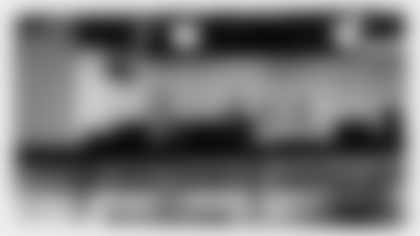The NFL Scouting Combine returns to Indianapolis, as hundreds of college players will try to improve their stock with teams before the 2020 NFL Draft in April.
For the past two weeks, Redskins head coach Ron Rivera has been evaluating the entire roster to see what needs to be improved before the upcoming campaign. The combine is one of many opportunities for he and the coaching staff to look at players who could help build the team into a contender.
Last year, the Redskins drafted six players who were invited to the combine. They were each given a prospect grade by NFL.com to show their potential level of success at the professional level. Although the grades differed for each pick, they showed enough skill for the Redskins to take a chance on them.
Below are the Redskins' six draft picks who were at the 2019 combine and an evaluation on how they performed.
1. Dwayne Haskins, QB
Prospect grade: 6.7/7 (Year 1 quality starter)
Haskins didn’t do much in terms of individual drills; he only participated in the 40-yard dash and vertical jump. His numbers weren't flashy in either of those drills, as he had a 40 time of 5.04 seconds and a 28.5-inch vertical.
He also showed off his arm by throwing to receivers, and that's what impressed analysts the most about his performance. Haskins was on time and accurate with his throws. Commentators on NFL Network pointed out the velocity on his passes, saying the ball "jumps out of his hand." His arm strength, which was one of his biggest assets as a draft prospect, was on display as he threw passes that traveled 50 yards downfield.
Haskins said after his performance that he thought he "spinned it" and he would let the scouts evaluate him. As for his interviews, he said he talked with about 12 teams and they all were positive.
"I felt like they all were impressed with me and thought I knew my playbook pretty well," Haskins said on NFL Network. "I had a good conversation with all of them, so I'm looking forward to what they're gonna do next."
2. Montez Sweat, EDGE
Prospect grade: 6.8/7 (Year 1 quality starter)
It was already obvious that Sweat had unique intangibles. At 6-foot-6 and 260 pounds, he had a nearly 36-inch wingspan and 10 1/2-inch hands. His numbers at the combine were even more impressive.
Sweat started his day by breaking a modern record for defensive linemen. He ran the 40-yard dash in 4.41 seconds, which is the fastest for the position since the record was first recorded in 2003. The previous record (4.44) was held by Manny Lawson in 2006 and Isaac Hilton in 2004. Lawson was a first-round pick, while Hilton was selected by the New York Giants in the seventh round.
Sweat went on to have an impressive day. He had 21 reps on the bench press, a 36-inch vertical and a 125-inch broad jump. That, combined with a seven-second three-cone drill and a 20-yard shuttle of 4.29 seconds, helped Sweat become the second-highest graded edge rusher in 2019 behind only Jacksonville Jaguars pick Josh Allen.
3. Terry McLaurin, WR
Prospect grade: 6.1 (Good backup who could become a starter)
After a strong showing at the Senior Bowl, there was already a lot to like about McLaurin at the combine. His routes were quick, crisp and precise. His hands, which then-Ohio State head coach Urban Meyer said needed to improve before he was offered a scholarship, were in good shape as he caught passes from multiple quarterbacks.
He also answered some questions about his skillset. He was making catches with his hands, rather than his body, and had acceleration early in his routes. He was able to make quick changes while running and had good pace, both of which were points of criticism for him.
On top of that, McLaurin had solid numbers in his individual drills, including a blazing 4.35 40-yard dash time. His prospect grade was a 6.1, but he was already showing flashes of what he would become with the Redskins.
4. Ross Pierschbacher, C
Prospect grade: 5.8/7 (Backup/special-teamer)
Pierschbacher came to the combine after a career at the University of Alabama as a four-year starter. Although he lacked size to some analysts, his technique was solid enough for them to think he could become an early starter with the right opportunity.
Pierschbacher's combine drills weren't among the best, but they were decent. He had a 5.2 40-yard dash time and a 4.7 20-yard shuttle run. He also had 20 reps on the bench press and a 22.5-inch vertical jump.
But his technique was what impressed scouts the most. He had good balance, smooth lateral movement and a solid base in pass and run blocking. He graded out as the fifth-best center prospect, according to NFL.com, and one of six drafted from the position.
5. Kelvin Harmon, WR
Prospect grade: 6.1/7 (Good backup who could become a starter)
Harmon actually received the same prospect grade as McLaurin. He was bigger, taller, had a longer wingspan and larger hands than the former Buckeye.
The difference was that his combine numbers were slightly below McLaurin's in several categories. He had a slower 40-yard dash time (4.6), a shorter vertical jump (32.5) and a slower 20-yard shuttle (4.32). He also wasn't as proficient in space or as a vertical threat.
Still, Harmon was thought to be a big target who could track passes in the air and aggressive in his routes. He was predicted to be drafted in the fourth or fifth round. The Redskins picked him up in the sixth.
6. Jordan Brailford, EDGE
Prospect grade: 5.9/7 (Backup/special-teamer)
Brailford wasn’t one of the highly-touted edge rushers in the 2019 draft class. He was tied for the 11th-best prospect with a grade of 5.9 and was the last edge rusher taken in the draft.
His combine numbers weren't that far off from Allen's, who was the Jaguars drafted seventh overall. He was .03 seconds slower than Allen on the 40-yard dash and had 22 reps on the bench press compared to Allen's 28. He also had a longer broad jump by eight inches.
Brailford's prospect grade was hurt the most when it came to his length. His wingspan was slightly shorter than Allen's and he was 6-foot-3 compared to Allen, who stood at 6-foot-5. He was also 10 pounds lighter.
Brailford had experience defending zone-read offenses and could drop back into coverage as an outside linebacker. That versatility was enough to make the Redskins pick him up in the seventh round.















